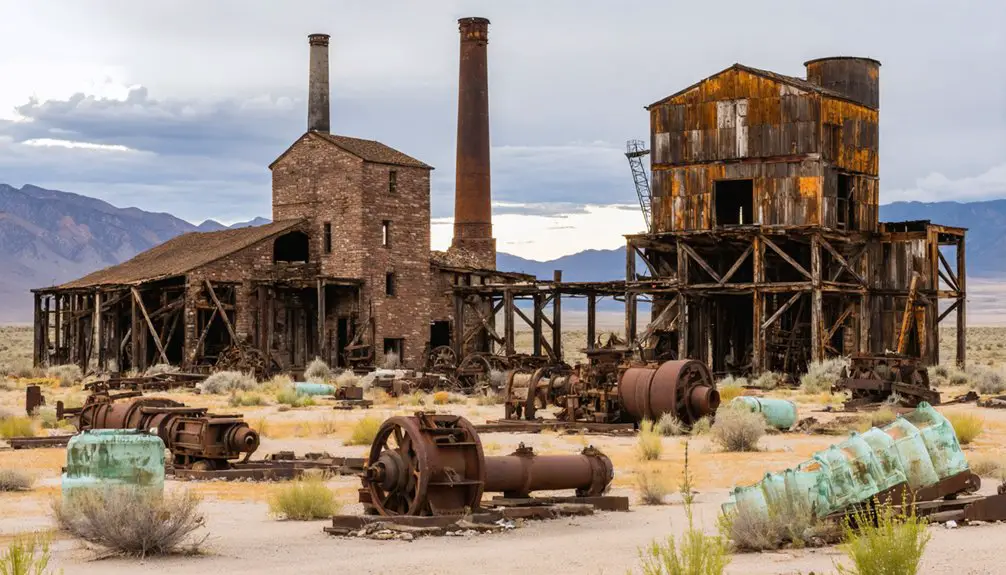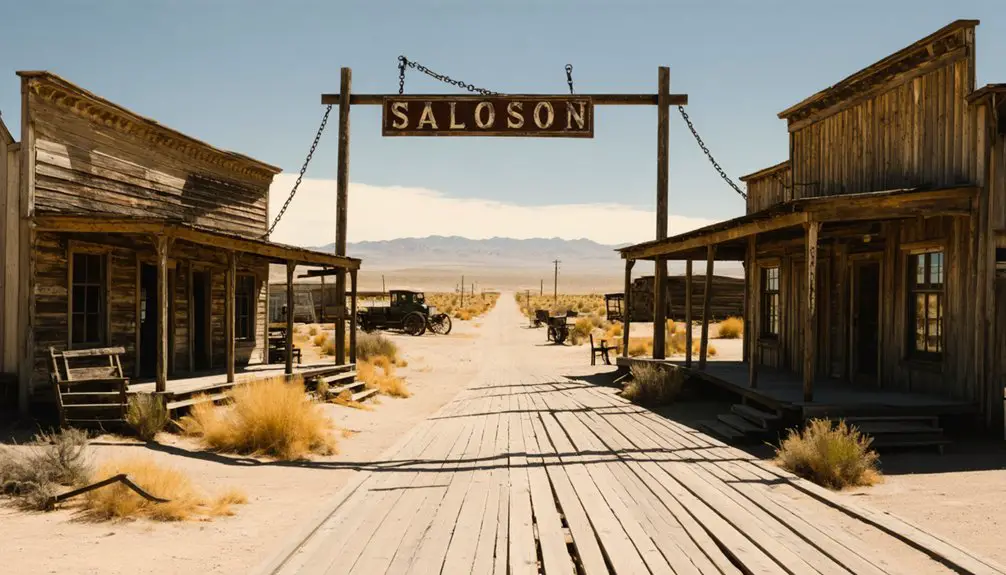You’ll find White Cloud City’s ruins in Nevada’s White Cloud Canyon, where copper deposits were discovered in 1868 by Major B.B. Bee and Frederick Smith. The settlement struggled with Native American conflicts, low-grade ore quality, and infrastructure challenges, maintaining only 40 residents at its peak. A 30-ton smelter operated briefly in 1893, but the site later transformed into Coppereid in 1907 before a 1950s flood ended mining operations. The ghost town’s scattered remains tell a deeper story of Nevada’s mining era.
Key Takeaways
- White Cloud City emerged after copper deposits were discovered in 1868 by Major B.B. Bee and Frederick Smith in White Cloud Canyon.
- The mining settlement supported a modest population of about 40 residents during its peak in the late 1800s.
- A 30-ton smelter operated at the canyon mouth, with a 3,790-foot tramway transporting ore from the mines.
- The site faced challenges including Native American conflicts, low-grade ore quality, and insufficient water supplies.
- Today, visitors can explore ruins including stone foundations, rusted mining equipment, and tramway remnants in the Nevada desert.
The Discovery of White Cloud Canyon’s Copper Riches
When Major B.B. Bee and Frederick Smith first stumbled upon copper deposits in White Cloud Canyon in 1868, they couldn’t immediately capitalize on their discovery. Local Native American tribes created conflicts that delayed the official organization of mining operations until 1869.
Once the White Cloud Canyon Mining District was established, you’d have found a small but bustling camp of about 40 residents, complete with a general store and saloon. The early copper discoveries showed promising signs – surface mining revealed an impressive copper belt stretching 8 to 10 miles long and 2 to 4 miles wide. John C. Fall began early mining work in the district during the 1870s.
While investors attempted to establish White Cloud City as a proper settlement, the mining techniques of the era weren’t advanced enough to make the venture profitable, and the initial townsite was soon abandoned. The area remained quiet until the Nevada United Mining Company expanded operations in 1907.
Early Settlement and Mining Challenges
Despite initial hopes for a thriving mining settlement, White Cloud City faced significant challenges from its earliest days. Cultural conflicts with local Paiute tribes delayed mining organization until 1869, while economic struggles kept the population limited to around 40 residents.
You’ll find the settlement’s key challenges reflected in these essential factors:
- Limited mining profitability due to low-grade ore quality
- Incomplete infrastructure, including an unrealized railroad connection
- Geographic isolation that hampered supply access and labor recruitment
The town’s development stalled despite efforts to attract investors through platting and vital services like a general store and saloon.
Rise and Fall of the Smelter Years

As the White Cloud Copper Mining Company of New York launched its ambitious smelting operation in April 1893, you’d find a bustling 30-ton capacity smelter emerging at the mouth of White Cloud Canyon.
The economic impact was immediate, spawning the small settlement of Clemens with about 35 residents, complete with boarding houses and saloons to support the mining workforce.
You’ll notice the company’s determination through their infrastructure investments, including a 3,790-foot tramway built by California Wire Works to transport ore efficiently.
Despite these efforts, smelter operations struggled with persistent challenges – insufficient ore profitability, water supply issues, and the absence of promised railroad connections.
Coppereid: A New Chapter in Mining History
The discovery of copper in White Cloud Canyon by Major B.B. Bee and Frederick Smith in 1868 marked the beginning of a new era.
After initial small-scale operations and a brief smelter period, John T. Reid revolutionized the area in 1906 by incorporating Nevada United Mining Company.
The Coppereid community emerged in 1907 with mining innovations that included:
- A steam hoisting plant for efficient ore extraction
- Modern compressor systems for enhanced drilling
- Expanded infrastructure including boarding houses and stores
You’ll find Reid’s management transformed the district from basic prospecting into an industrialized operation, complete with a post office and plans for railroad connectivity.
While water intrusion challenges persisted, the mine remained active, producing significant copper ore until a devastating flood in the early 1950s permanently halted operations.
The site’s contact metamorphic deposits yielded not only copper but also iron, tin, silver, and gold through thermal alteration of limestone beds.
Like many mining operations of the era, the site experienced typical boom-bust cycles that characterized Nevada’s mining history from the 1860s through the early 1900s.
Legacy and Remnants in the Nevada Desert
Walking through White Cloud Canyon today, you’ll find scattered remnants of Nevada’s copper mining legacy amid the stark desert landscape. Rusted mining equipment and crumbling stone foundations mark where this ambitious ghost town once stood, while the imposing Stillwater Range provides a dramatic backdrop to the historical site.
You can still trace the outline of the 3,790-foot tramway that served the 30-ton smelter near the canyon mouth, though the railroad extension never materialized. The site draws adventure-seeking tourists year-round who come to photograph and explore the weathered structures. The area’s well-drained soils on the mountain slopes support distinct vegetation patterns that add to the site’s unique character.
The site’s historical significance extends beyond its physical remains – it represents the classic boom-and-bust cycle of Western mining towns. While the dreams of copper riches faded by 1912, the preserved ruins offer a compelling glimpse into Nevada’s mining era, drawing history enthusiasts to explore these authentic remnants of frontier industrialization.
Frequently Asked Questions
What Happened to the Native American Tribes After Mining Began?
You’ll find Native Displacement intensified as mining operations disrupted tribal lands, forcing communities from ancestral territories. They endured Cultural Impact through lost resources, damaged farming areas, and spiritual disconnection from sacred spaces.
Are There Any Surviving Photographs of White Cloud City or Coppereid?
You’ll find limited historical documentation through black and white photographs of stone ruins and smelter remains. Modern photographic evidence exists mainly through ghost town enthusiasts’ images and digital archives.
How Deep Were the Copper Mines in White Cloud Canyon?
While you’d expect massive depths from historic copper mines, White Cloud Canyon’s reached just 315 feet down, with initial copper found at 145 feet. Mining technology couldn’t overcome persistent flooding issues.
Is the Site Accessible to Visitors Today by Vehicle?
You can reach the site by vehicle, but you’ll need four-wheel drive due to rough road conditions. Follow visitor guidelines: bring emergency supplies, check weather, and guarantee your vehicle has high clearance.
Were Any Major Accidents or Deaths Recorded During Mining Operations?
While specific records aren’t available for this site, mining hazards were common throughout Nevada’s mining districts, and worker safety was often compromised, suggesting deaths likely occurred during active operations here.
References
- https://nvtami.com/2021/03/10/coppereid-white-cloud-city-nevada/
- https://www.nvexpeditions.com/churchill/coppereid.php
- https://en.wikipedia.org/wiki/Coppereid
- https://en.wikipedia.org/wiki/List_of_ghost_towns_in_Nevada
- https://www.youtube.com/watch?v=2xkeZZcl6ek
- https://www.churchillcountynv.gov/DocumentCenter/View/15536/2020-Master-Plan-Appendix-E-List-of-Historic-Sites-in-Churchill-County
- https://westernmininghistory.com/library/38189/page1/
- https://utahrails.net/pdf/Elliott_KCC-Nevada-History.pdf
- https://shpo.nv.gov/uploads/documents/McBride_-_Exploration_and_Early_Settlement_in_NV
- https://nnss.gov/wp-content/uploads/2023/04/DOENV_713.pdf



